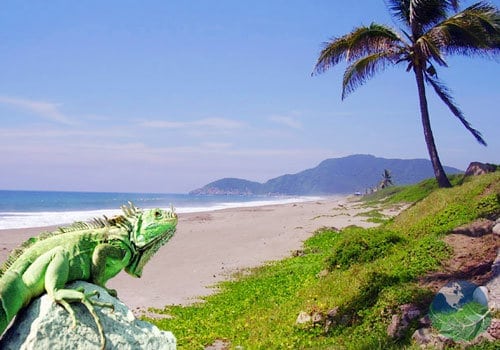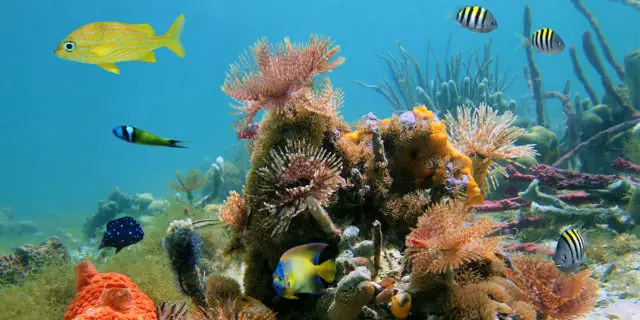On your next visit to beautiful Costa Rica do not forget to enjoy a few days of relaxation and healthy recreation in the paradisiacal “Isla del Coco National Park”. Located in the Pacific Ocean, 532 km from the coast of Cabo Blanco. It is made up of Cocos Island and some surrounding islands and islets, plus an extension of surrounding maritime territory.
It has an area of 2,400 ha in the land area and 97,235 ha in the marine space. The national park was created by Executive Decree on June 22, 1978. The island is considered a natural laboratory for the study of species evolution. It is extremely rainy, about 7,000 mm per year, covered by an evergreen forest, which maintains cloudy conditions on Cerro Iglesias (the highest point in the island).
It is said that its name derives from a large number of coconuts that are on the island, but a metaphorical version of its resemblance to a coconut with a lot of water is gaining strength, given the shortage of drinking water in hundreds of kilometers around and on the other hand, there are more than 2000 waterfalls that fall into the sea during the long rainy season.
Topography.
It has a very irregular surface, which results in the formation of many waterfalls, some of which fall spectacularly to the sea, from high altitudes. The coast is very winding, with cliffs up to 183 meters high and numerous underwater caves. The sea, turquoise blue has extraordinary transparency.
History.
The Island was discovered in 1526 by the navigator Joan Cabezas and is mentioned for the first time in 1541 as “Coques” on the cartographic map of Nicolás Desliens. It is assumed that the island had been discovered before that date but this has not been corroborated.
During the seventeenth and eighteenth centuries, it was a refuge for pirates and privateers who flourished along the Pacific coast of Spanish America. Among the most notorious pirates in history who took refuge on that island, there is the talk of the legendary captains Morgan, Edward Davies, and William Thompson. According to legends, valuable treasures were hidden here such as the treasure of William Davies that was hidden in 1684 and that of Benito “Bloody Sword” Bonito in 1819.
The “Lima” Treasure.
This story begins in Lima, Peru in the year 1820 during a revolution that gave rise in that city. The Spanish navy authorities decided to protect their treasures, consisting of tons of gold and silver ingots, gold sheets that covered Church domes, by taking them out by ship. Unfortunately for the Spaniards, Captain Thompson, who was in charge of directing this task, says that he went to Cocos Island and according to history, was forced to bury it there because the Spanish Navy pursued him after putting down the revolution.
Around 1869, the then president of Costa Rica, Jesús Jiménez, ordered the inclusion of the island as part of the Costa Rican territory. To that end, he organized an expedition that was led by Mr. Rafael Oreamuno, who raised the flag of the Republic of Costa Rica for the first time on the island. Years later, during the administration of Tomás Guardia (1876-1882) the island was destined as a penal colony for political prisoners.
In 1889, Augusto Gissler arrived at Cocos Island and later was appointed Lieutenant-Governor between 1897 and 1906. Gissler, who spent 18 years of his life in the search for the Lima treasure, is the very embodiment of the phenomenon of “hidden treasures fever”. It is said that he met in Hawaii a very old man known as Old Macó, who claimed to be the grandson of one of the survivors of the looting of Lima. Based on this story, Gissler never gave up looking for the Treasure of Cocos Island, but to date the results of that search are unknown.
Despite this, a verbal tradition story is mentioned about a man named John Karting, who was able to find the hidden treasure and took part in it. Mr. Karting became a wealthy industrialist who on his death bed told his family about his experience on the island after a shipwreck and how he was able to locate the treasure and salvaging part of it.
These riches have attracted more than 500 expeditions, including one from the Government of Costa Rica that took possession of the Island on September 15, 1869. The French explorer and researcher Jacques-Yves Cousteau considered Isla del Coco as the most beautiful in the world.
A true wonder of nature and a real treasure for scientists. Ferns, bromelias, rivers, streams, and waterfalls abound; valleys, cliffs, and islets frequented by countless seabirds. It has been possible to identify 100 species of birds, of which three are endemic; 5 reptiles, two of them unique, and 400 species of insects of which 65 are endemic. Besides, almost 60 species of crustaceans have been cataloged, more than 100 mollusks and 18 corals. In its waters, whitefin sharks, giant hammerhead sharks, whale sharks, blankets, dolphins and horse mackerels proliferate. It is also easy to find large banks of pike and tuna, green turtles and octopus.
Protection.

The park has several protection programs. They ensure compliance with the laws of conservation of natural resources, maintaining an adequate balance of the island’s ecosystems within the marine and terrestrial limits. Another function is to ensure the safety of national and foreign visitors who arrive on the island.
The Administration Program intends to achieve the coordination of all the conservation activities in the park in the short and medium-term. The Research and Monitoring Program intends to lay the foundations for the development of scientific research in the area and encourage it, according to the park’s priorities. Finally, the Public Use Program, whose objective is to raise awareness among the groups engaged in fishing activity in the surrounding marine limits, on the importance of preserving the populations of marine organisms for commercial use that are most threatened.
As part of the protection, infrastructure is being built that includes cabins for park rangers, scientific laboratories and fixed positions in strategic sites for the control and monitoring of tourist activity as well as illegal fishing, all under strict principles of low environmental impact, which have been in charge of the renowned bioclimatic and environmentalist architects Ibo Bonilla and Rafael Víquez, who have carried out projects in multiple national parks and protected areas.
Adventures in Cocos Island.
If you want to come to this Garden of Eden, there are tour operators that offer programs that include ground transportation from San José to Puntarenas, transportation and accommodation in Ferries, food and entrance fees, among other services. Keep in mind that this island enjoys maximum protection, so there are no places to spend the night or eat.

On the other hand, and concerning the
desire of keeping this virgin paradise intact, commercial and sport fishing,
the introduction of exotic plant and animal species and the
alteration of the medium in any aspect are all strictly prohibited. Camping is
also not allowed.
Currently, there is a great demand for recreational, natural and scientific tourism because of the attraction that the bays of Chatham, Wáter, and Iglesias have. These are magnificent places to practice recreational scuba diving, the favorite activity of tourists. You can also dive near the Pájara Islands, Manuelita Island, and Roca Sumergida.

